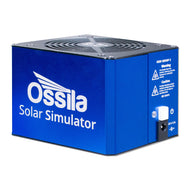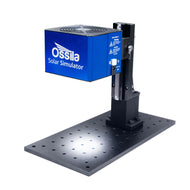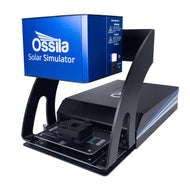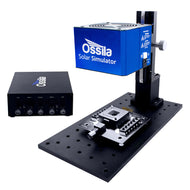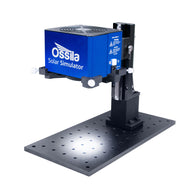Solar Simulator
Buy a solar simulator | Choose the right system | Accessories | Classification | Resources | Technical support
Use the right solar simulator system for your experimental needs, from a standalone lamp to a complete solar cell testing kit. With a high-power LED light source, implement a reliable and tunable spectrum into your photosensitive research applications. Each system is carefully calibrated according to the latest IEC standards.
Glove Box Ready
We've heard that other LED solar simulators develop issues over time when used in a glove box environment so, to confirm that ours are glove box compatible, we ran some stability experiments.
We tracked the output of our solar simulator over a period of 2 months within a 0.1 ppm glove box*. Over this time, there was no significant deterioration of solar simulator performance. The Ossila solar simulator showed no significant long-term or short-term fluctuation in irradiance over this time scale. We also found that our systems went through vacuum antechambers with no damage to the instrument.
*These experiments took place inside a glove box with no solvent processing. Heavy solvent processing may damage some components of the solar simulator. We recommend using Ossila solar simulators in solvent-free glove boxes.
Buy a Solar Simulator
Need help choosing the right system?
Classification of Ossila Solar Simulators
Designed for small areas, the output is AAA rated over a 15mm diameter illuminance area and adheres to the latest solar simulator standards (IEC 60904-9:2020). By default, the solar simulator outputs 1 sun of illuminance (100 mW/cm2) over the wavelength range of 350 nm – 1000 nm but you can adjust the optical output power down to an illuminance of 10 mW/cm2 if needed. You can also individually control the output power of each of the 11 LED wavelengths.
With our indoor light filter, you can also mimic indoor spectra according to recent IEC TS 62607-7-2:2023 international standards for testing indoor solar cells.
| LED Solar Simulator Lamp | With Indoor Light Filter | |
|---|---|---|
| Spectral match | A | A |
| Spatial uniformity over 15 mm diameter area | A | B |
| Spatial uniformity over 25 mm diameter area | B | C |
| Spatial uniformity over 32 mm diameter area | C | N/A |
| Temporal instability | A | SA |
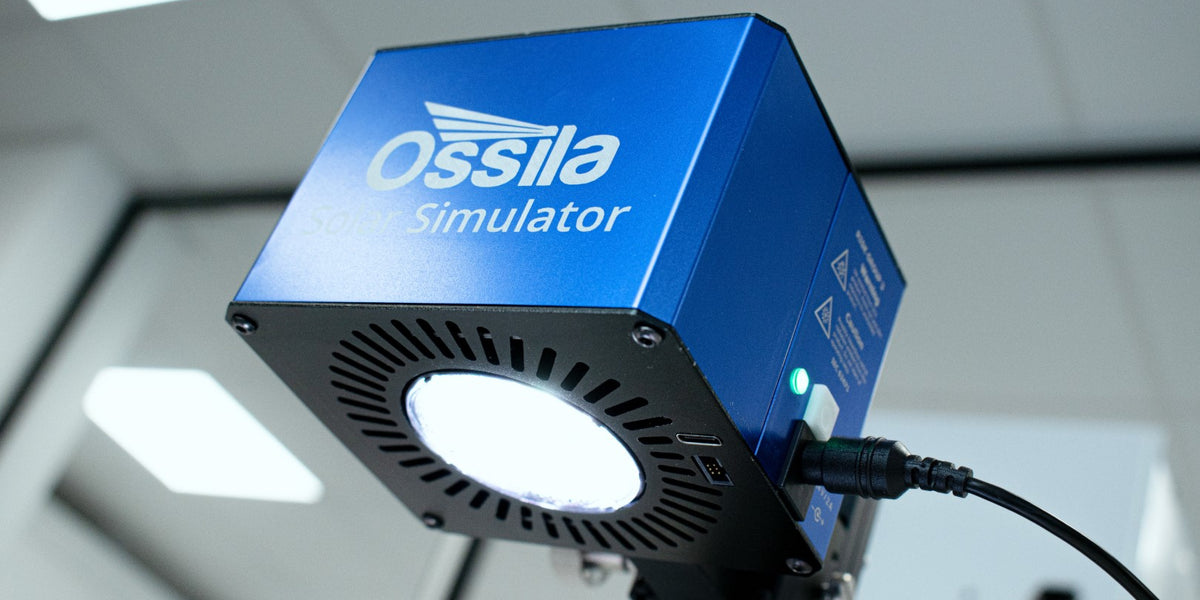
Accessories and Components
Choose the Right System
Based on our high-power LED technology, we have five solar simulator systems to choose from. Our range is designed to fit many different budgets and experimental requirements. When you choose the right system you can get set up and start testing quickly and easily, and forget the hassle of adjusting your experiments to accommodate unsuitable equipment.
| System | What it's best for |
|---|---|
| LED Solar Simulator Lamp | Cost-effective option for integrating a light source into your existing setup. |
| LED Solar Simulator | A simple, modular setup to reliably and accurately mimic the solar spectrum. |
| Automated Solar Cell Testing Kit | Complete solution for simple solar cell testing with a light source and test system. |
| Manual Solar Cell Testing Kit | Flexible solar cell characterization with a solar simulator and source measure unit. |
| Indoor Light Simulator | Consistent indoor and outdoor photovoltaic testing with a detachable light filter. |
The Benefits of LED
LED solar simulators are more energy-efficient and cost-effective than traditional arc lamps. They reliably deliver a high-quality spectrum that mimics AM 1.5G over the 350–1000 nm range, achieving a reliable Class A spectral match. With significantly lower warm-up times than arc lamps, you can take fast, consistent measurements and with lifespans exceeding 10,000 hours, LED light sources last longer, reducing downtime and replacement costs.
Take full control over the spectral output with the LED arrays in Ossila solar simulator systems. Adjust the intensity of individual LEDs to replicate a wide range of lighting conditions, including indoor or low-light environments with the indoor light filter. Plus, you can add an Ossila system to any lab space or test sensitive materials inside a glove box, thanks to the compact design.
Resources
Buying Guides
 Solar Simulator Light Sources
Solar Simulator Light Sources
Choosing the right light source for your solar simulator is one the most important decisions to make when setting up a PV testing laboratory.
Read more...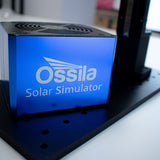 Why You Should Buy the Ossila Solar Simulator
Why You Should Buy the Ossila Solar Simulator
A solar simulator is an essential piece of equipment for any lab working with photovoltaics, optoelectronics, or any research that requires a simulated sunlight environment.
Read more...Maintenance and Operation
 How to Set Up a Solar Simulator Light Source
How to Set Up a Solar Simulator Light Source
The solar simulator light source is compact, lightweight and can be easily installed in any lab using adjustable height stand provided with it.
Read more... How to Check Solar Simulator Calibration
How to Check Solar Simulator Calibration
It is important to ensure that your solar simulator is outputting a consistent spectral output. Different solar simulators will have different bulb lifetimes.
Read more... Automated Solar Simulator Assembly
Automated Solar Simulator Assembly
This system was designed to be easy to use, and effortless to assemble. This video and subsequent guide will demonstrate how easy setting up your testing lab can be with the Ossila Automated Solar Cell Testing Kit.
Read more... Measuring J-V Curves with Ossila Solar Cell Testing Equipment
Measuring J-V Curves with Ossila Solar Cell Testing Equipment
When it comes to testing the performance of solar cells, accurate measurements and reliable equipment are essential. If you are conducting research into PV materials, understanding how to measure and interpret J-V curves is crucial in assessing device performance
Read more...Applications
 Solar Cell Testing & Characterization
Solar Cell Testing & Characterization
One main application of a solar simulator is to test solar cell devices and modules. To characterize how solar cells will perform in the real world, it is vital that you use a solar source that mimics the suns spectrum well. You could of course use actual sunlight, but this is an uncontrollable variable.
Read more... Analyzing and Improving Low Device Metrics: FF, VOC and JSC
Analyzing and Improving Low Device Metrics: FF, VOC and JSC
Anaylzing key device metrics such as fill factor (FF), open-circuit voltage (VOC), and power conversion efficiency (PCE), can help you find potential issues with your solar cell devices
Read more...Use the following Python code to plot this data using Panda DataFrames. Just copy and paste the code below into your Python virtual environment and start plotting.
Read more...The aim of this article is to contextualise the spectral irradiance graphs you see throughout our website and elsewhere.
Read more... Interpreting J-V Curves: Insights into Solar Cell Performance
Interpreting J-V Curves: Insights into Solar Cell Performance
With so many variables in a PV device, it can be difficult to pinpoint the exact issue affecting your solar cell's performance.
Read more...Technical Support
